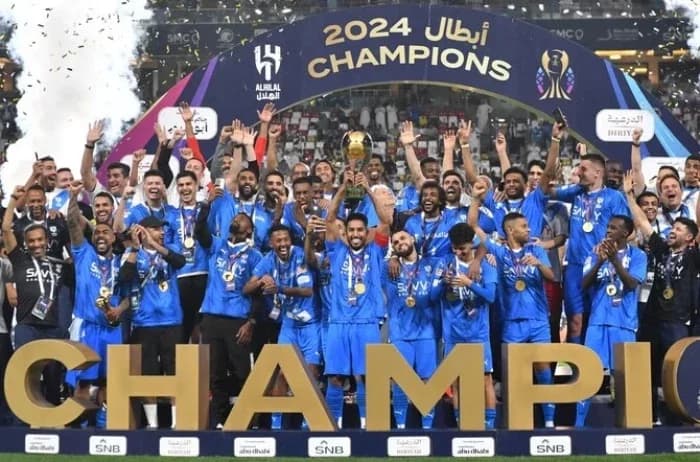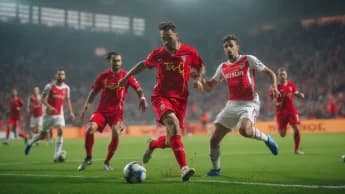The Saudi Pro League is rapidly transforming into a powerhouse in global football, attracting superstars and reshaping competitive dynamics, while seeking sustainable growth for the future.
The Saudi Pro League (SPL) has swiftly gained recognition as one of the most discussed football leagues globally, primarily due to a wave of high-profile international signings. In the past year, the SPL has experienced an impressive surge of football superstars, altering the competitive dynamic and challenging the long-standing dominance of European football. This trend, largely propelled by the substantial financial backing of the Saudi Public Investment Fund (PIF), has sparked inquiries regarding the league's ambitions and its broader impact on global football. This blog examines the significance of these major signings on the Saudi Pro League, investigating the factors driving this trend, potential long-term outcomes, and the concerns it has raised within Europe.
The Ascendancy of the Saudi Pro League: An Economic Giant
In recent years, the Saudi Pro League has experienced a remarkable surge in talent acquisition, attracting international superstars such as Cristiano Ronaldo, N'Golo Kante, Jordan Henderson, and most recently, Neymar, who have made significant transfers to the league. This influx has primarily been driven by the Saudi government's initiative to establish the nation as a global sports destination. The Public Investment Fund's investments in leading clubs like Al-Nassr, Al-Ittihad, and Al-Hilal have provided the essential financial resources needed to pursue players who were once out of reach for most Asian clubs.
The acquisition of Cristiano Ronaldo by Al-Nassr in December 2022 marked a pivotal moment in this transformation. Ronaldo's contract, reportedly worth an impressive £173 million per year, shifted the focus onto the Saudi Pro League, establishing it as a prominent venue within the global football landscape. Following this landmark signing, the league has successfully attracted a diverse array of star players, including French midfielder N'Golo Kante, Liverpool's captain Jordan Henderson, and potentially Neymar, for whom Al-Hilal could offer £77.6 million to Paris Saint-Germain (PSG), thereby enhancing the league's international reputation.
A central aim of these signings is to enhance the international profile of the Saudi Pro League. Traditionally, the SPL has been eclipsed by European leagues such as the Premier League, La Liga, and Serie A. However, the influx of top-tier football talent has brought the Saudi league into the global limelight, with games now being broadcast throughout Europe, Asia, and the Middle East.
The arrival of internationally recognized players has notably attracted interest from media outlets and sponsors. Ronaldo's signing transformed Al-Nassr's matches into a worldwide spectacle, resulting in heightened viewership and an expanded market for broadcasting rights. The SPL’s efforts to create a more competitive and appealing league are clear, as clubs are making significant investments not only in players but also in coaching and infrastructure.
Economic and Cultural Impact
The financial influence of these signings is significant. The Saudi Pro League plays a crucial role in the country's Vision 2030 initiative, which seeks to reduce reliance on oil by investing in areas such as sports, entertainment, and tourism. Through the acquisition of renowned global players, Saudi Arabia aims to establish itself as a key destination for international sporting events, thereby enhancing tourism and generating new economic prospects. Moreover, the involvement of high-profile athletes like Ronaldo, Kante, and Henderson helps to foster a favorable image of the nation on the world stage, thereby enhancing its soft power in the realm of international relations.
Culturally, the signings serve to generate enthusiasm for football throughout the nation. The Saudi government has a long-standing commitment to supporting the sport, as evidenced by the national team's successes in both the AFC Asian Cup and World Cup qualifiers. The influx of prominent foreign players, however, brings a renewed sense of pride and excitement to local supporters, many of whom have historically followed European clubs. With a fervent football fanbase, the Saudi Pro League is working to establish itself as a true competitor to European leagues in both quality and marketability.
Economic Sustainability
While the Saudi Pro League has seen notable success in recruiting star players, concerns regarding the sustainability of this approach are significant. Critics worry that the league’s reliance on state-supported funding may not prove viable in the long run. The Chinese Super League (CSL) encountered similar issues during its spending frenzy in the mid-2010s, attracting older players like Carlos Tevez and Oscar. Ultimately, the CSL's financial strategy collapsed, resulting in reduced foreign investment and a slump in player acquisitions.
For the Saudi Pro League, a significant challenge will be to ensure that investments in foreign players are harmonized with strategies for long-term development. Experts suggest that the league should prioritize youth development, cultivate local talent, and enhance domestic competition to prevent its growth from being artificially stimulated.
Effects on European Football
The increasing financial might of Saudi Arabia poses a significant challenge to European football, especially with the recent arrival of key players such as Ruben Neves and Neymar. The substantial transfer fees and high salaries that Saudi clubs are offering make them an appealing option for players, particularly those who are approaching the end of their careers or looking for financial stability.
European teams, including Chelsea and Wolves, have faced challenges due to Financial Fair Play (FFP) rules, which limit their spending in relation to their earnings. In contrast, Saudi clubs are able to present lucrative offers that many European clubs find hard to compete with. Consequently, top clubs in Europe are now facing the reality of a competitive Saudi market, which could lead to a talent drain if the financial gap continues to widen.
There are indications that European football is not resigned to this situation. UEFA President Aleksander Ceferin has expressed doubts regarding the Saudi Pro League's approach of acquiring older players, contending that it does not foster long-term growth. He recommended that the Saudi Pro League prioritize the development of homegrown talent and invest in youth academies instead of continuing to attract aging players from Europe.
Future Perspectives: What Lies Ahead?
The outlook for the Pro League is encouraging, with ambitious initiatives aimed at enhancing its status as a leading global competition. If the league can leverage its current momentum by concentrating on sustainable development and nurturing players, it has the capability to challenge Europe’s premier leagues in the future. Nevertheless, achieving this will necessitate meticulous planning and management to prevent the missteps encountered by other leagues that have attempted and failed to become dominant global entities.
The recent influx of star players is only the beginning. Should the Saudi Pro League continue to draw top-tier talent while exercising financial caution and investing in the development of local football, it has the potential to emerge as a formidable presence on the global stage, presenting a realistic alternative to Europe’s established footballing powerhouse.
Concluding Thoughts
The arrival of prominent international signings has undeniably transformed the Saudi Pro League, raising its profile and enhancing its competitiveness on the world football stage. Although the financial support from the Saudi government lays a strong groundwork, the league's long-term success will hinge on its ability to strike a balance between investing in international stars and nurturing local talent alongside sustainable business practices. If managed effectively, the Saudi Pro League holds the potential to become a formidable contender to Europe’s footballing powerhouses in the future.
The Saudi Pro League (SPL) has swiftly gained recognition as one of the most discussed football leagues globally, primarily due to a wave of high-profile international signings. In the past year, the SPL has experienced an impressive surge of football superstars, altering the competitive dynamic and challenging the long-standing dominance of European football. This trend, largely propelled by the substantial financial backing of the Saudi Public Investment Fund (PIF), has sparked inquiries regarding the league's ambitions and its broader impact on global football. This blog examines the significance of these major signings on the Saudi Pro League, investigating the factors driving this trend, potential long-term outcomes, and the concerns it has raised within Europe.
The Ascendancy of the Saudi Pro League: An Economic Giant
In recent years, the Saudi Pro League has experienced a remarkable surge in talent acquisition, attracting international superstars such as Cristiano Ronaldo, N'Golo Kante, Jordan Henderson, and most recently, Neymar, who have made significant transfers to the league. This influx has primarily been driven by the Saudi government's initiative to establish the nation as a global sports destination. The Public Investment Fund's investments in leading clubs like Al-Nassr, Al-Ittihad, and Al-Hilal have provided the essential financial resources needed to pursue players who were once out of reach for most Asian clubs.
The acquisition of Cristiano Ronaldo by Al-Nassr in December 2022 marked a pivotal moment in this transformation. Ronaldo's contract, reportedly worth an impressive £173 million per year, shifted the focus onto the Saudi Pro League, establishing it as a prominent venue within the global football landscape. Following this landmark signing, the league has successfully attracted a diverse array of star players, including French midfielder N'Golo Kante, Liverpool's captain Jordan Henderson, and potentially Neymar, for whom Al-Hilal could offer £77.6 million to Paris Saint-Germain (PSG), thereby enhancing the league's international reputation.
A central aim of these signings is to enhance the international profile of the Saudi Pro League. Traditionally, the SPL has been eclipsed by European leagues such as the Premier League, La Liga, and Serie A. However, the influx of top-tier football talent has brought the Saudi league into the global limelight, with games now being broadcast throughout Europe, Asia, and the Middle East.
The arrival of internationally recognized players has notably attracted interest from media outlets and sponsors. Ronaldo's signing transformed Al-Nassr's matches into a worldwide spectacle, resulting in heightened viewership and an expanded market for broadcasting rights. The SPL’s efforts to create a more competitive and appealing league are clear, as clubs are making significant investments not only in players but also in coaching and infrastructure.
Economic and Cultural Impact
The financial influence of these signings is significant. The Saudi Pro League plays a crucial role in the country's Vision 2030 initiative, which seeks to reduce reliance on oil by investing in areas such as sports, entertainment, and tourism. Through the acquisition of renowned global players, Saudi Arabia aims to establish itself as a key destination for international sporting events, thereby enhancing tourism and generating new economic prospects. Moreover, the involvement of high-profile athletes like Ronaldo, Kante, and Henderson helps to foster a favorable image of the nation on the world stage, thereby enhancing its soft power in the realm of international relations.
Culturally, the signings serve to generate enthusiasm for football throughout the nation. The Saudi government has a long-standing commitment to supporting the sport, as evidenced by the national team's successes in both the AFC Asian Cup and World Cup qualifiers. The influx of prominent foreign players, however, brings a renewed sense of pride and excitement to local supporters, many of whom have historically followed European clubs. With a fervent football fanbase, the Saudi Pro League is working to establish itself as a true competitor to European leagues in both quality and marketability.
Economic Sustainability
While the Saudi Pro League has seen notable success in recruiting star players, concerns regarding the sustainability of this approach are significant. Critics worry that the league’s reliance on state-supported funding may not prove viable in the long run. The Chinese Super League (CSL) encountered similar issues during its spending frenzy in the mid-2010s, attracting older players like Carlos Tevez and Oscar. Ultimately, the CSL's financial strategy collapsed, resulting in reduced foreign investment and a slump in player acquisitions.
For the Saudi Pro League, a significant challenge will be to ensure that investments in foreign players are harmonized with strategies for long-term development. Experts suggest that the league should prioritize youth development, cultivate local talent, and enhance domestic competition to prevent its growth from being artificially stimulated.
Effects on European Football
The increasing financial might of Saudi Arabia poses a significant challenge to European football, especially with the recent arrival of key players such as Ruben Neves and Neymar. The substantial transfer fees and high salaries that Saudi clubs are offering make them an appealing option for players, particularly those who are approaching the end of their careers or looking for financial stability.
European teams, including Chelsea and Wolves, have faced challenges due to Financial Fair Play (FFP) rules, which limit their spending in relation to their earnings. In contrast, Saudi clubs are able to present lucrative offers that many European clubs find hard to compete with. Consequently, top clubs in Europe are now facing the reality of a competitive Saudi market, which could lead to a talent drain if the financial gap continues to widen.
There are indications that European football is not resigned to this situation. UEFA President Aleksander Ceferin has expressed doubts regarding the Saudi Pro League's approach of acquiring older players, contending that it does not foster long-term growth. He recommended that the Saudi Pro League prioritize the development of homegrown talent and invest in youth academies instead of continuing to attract aging players from Europe.
Future Perspectives: What Lies Ahead?
The outlook for the Pro League is encouraging, with ambitious initiatives aimed at enhancing its status as a leading global competition. If the league can leverage its current momentum by concentrating on sustainable development and nurturing players, it has the capability to challenge Europe’s premier leagues in the future. Nevertheless, achieving this will necessitate meticulous planning and management to prevent the missteps encountered by other leagues that have attempted and failed to become dominant global entities.
The recent influx of star players is only the beginning. Should the Saudi Pro League continue to draw top-tier talent while exercising financial caution and investing in the development of local football, it has the potential to emerge as a formidable presence on the global stage, presenting a realistic alternative to Europe’s established footballing powerhouse.
Concluding Thoughts
The arrival of prominent international signings has undeniably transformed the Saudi Pro League, raising its profile and enhancing its competitiveness on the world football stage. Although the financial support from the Saudi government lays a strong groundwork, the league's long-term success will hinge on its ability to strike a balance between investing in international stars and nurturing local talent alongside sustainable business practices. If managed effectively, the Saudi Pro League holds the potential to become a formidable contender to Europe’s footballing powerhouses in the future.







